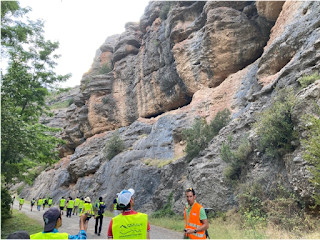ITN opportunities: Summer-schools (Part 1)
Since the beginning of the project, multiple interesting opportunities have been presented to us. We would travel each year to conferences like EGU, present and convene, introduce ourselves to the scientific community, make connections, go on different secondments according to our needs during our doctoral studies, but also opportunities to meet each other during the years, with one important meeting for everyone each year: the summer schools. It was the only time where all of us were together for multiple weeks, to exchange, learn and evolve in our respective fields, but also learn in more detail about the subjects of our colleagues. Some cooperation started between us thanks to those summer schools. To cite some, Marine and Philémon during Dragonstone, in Spain in 2021 or Amanda, Rocío, Nahin, Ariel and Marine during Inside Africa, in Namibia in 2023.
Thus, it is appropriate to present,
through this blog, an overview about the summer schools. We could talk about
each of them for days, and you can already have scientific glimpses through our
social media, reminiscing about each summer school for weeks afterwards. Here,
you will find a different picture of each, and why they are of such importance,
not just scientifically, but also socially.
1. Dragonstone: Source-to-sink systems, introduction through a fossil system in the Pyrenean foreland basin, online introduction and excursion in Spain, 2021.
It was the first time, after the
beginning of Covid19, that our group met, with a one-year delay, in August
2021. To fill the void in-between, a virtual training week was proposed first,
in January 2021, where we learned and were reminded of important skills, facts
and knowledge about geomorphology, sedimentology, modelling, and the
source-to-sink theory. At last, one year after the planned excursion, the team
came together from the 25th of August to the 09th of
September 2021 in Barcelona. It announced the beginning of our teamwork.
From Barcelona to Zumaia, passing the
Ebro basin, Graus-Tremp basin, Ainsa basin and Jaca Pamplona basin, we
travelled through 2 of the 3 stages in a source-to-sink system: the transport
zone of sediments and their “sink”. At the end, for 4 days, the doctoral
researchers stayed with François Guillocheau and sedimentologist Jean-Loup
Rubino in Ainsa, for an intensive course about the marine sink systems and core
science.
During Dragonstone, we could also
witness the field area and work of our colleagues Marine, Philémon and Rocío.
It was still during the pandemic, so our group stayed exclusively together, to prevent any possible infections. Very strict rules were followed for the sake of the success and health of the group… And what a success it was! Dragonstone ended with new knowledge and ideas for the future, with discussions and plans for secondments and visits.
2. The Factory: Modern source-to-sink systems, risks and management, Norway and Switzerland, 2022
From the 30th of May to
the 17th of June, our group spent time in Bergen, at the
Jostedalsbreen National Parc in Norway, Geneva and the Rhone Valley in
Switzerland.
During both stays, we looked at modern systems, their management and risks linked to them. In Norway, we were able to visit the Equinor offices, where different experts talked to us about energy management to cite some: off-shore wind farms, CO2 storage systems, resource data acquisition and their analysis. It was an interesting experience for us, not only scientifically, but it also enabled us to see how a leading energy company works from the inside. It was also the opportunity for us to discover the non-academic world, how it works, how it differs from academia, and how and where priorities are set in that environment.
In a country like Norway, nature is a
part of everyday life. In a positive but also in a negative way. Steep fjords
and cold temperatures are a recipe for frequent hazards, in the form of floods
but mostly slope failures (rockfalls, rockslides, landslides, and avalanches).
During our stay, our Norwegian supervisors Christian Haug Eide and Tor Oftedal
Somme organised a short excursion to the Jostedal Glacier. Along the way, we
went to a small camping site just below a rock wall, where we examined its risks
and what it means for the campers… It was safe 😉. When at the glacier
itself, we discussed climate change and effects on Norwegian but also worldwide
glacier retreat…
We thus left Norway for Switzerland
with lots to think about, but our new destination was also full of exciting
stops. In Switzerland, with Sébastien Castellort, Fritz Schlunegger, François
Guillocheau and Cécile Robin, we went on a tour of the Rhone valley, where we
stopped very actual landsliding sites, more or less destructive too! Here,
Ariel could tell us more about his research and what is going on in the area,
in a continuity of what we started in Norway: Valley management. We looked at
damming, check-dams and their influence on local processes. Also while in
Switzerland, multiple experts outside academia talked to us about gravel
mining, recycling engineering for concrete, nuclear waste storage problems due
to glaciations, inclusive and equality driven mining perspectives to cite some.
All in all, this training was a new
way for us to identify other career possibilities, geological questions and a
different, more engineering driven point of view on our scientific questions.
This side will be even further developed during the last, but certainly not the
least, training in Namibia!




Comments
Post a Comment